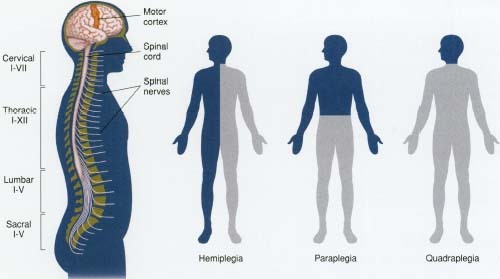Hemiplegia
From Psy3242
Hemiplegia describes the condition of a brain damaged individual who is unable to intentionally move parts of his or her body on the side opposite that of the brain damage. Hemplegia usually occurs as a result of a loss of blood supply in the mid-cerebral artery due to aneurysm, hemorrhage, or clot. It may also be caused by a head injury, epilepsy, and/or tumor. In addition, damage to subcortical structures, such as the basal ganglia, may result in hemplegia, since such structures are often served by the mid-cerebral artery.
Recovery
Hemiplegic Individuals are usually able to improve over time. Changes in bloody supply as well as blood loss result in cell death and loss of function in adjacent neurons. Most of these neurons are later able to return to a normal or near normal functioning level thereby allowing for the patient to have at least a partial behavioral recovery of function. Many patients have also proven to be adaptable by learning new ways of moving by using different brain regions.
Anosognosia in Patients with Hemiplegia
Anosognosia, a condition in which patients are unaware of his or her illness and/or the effects of that illness, occurs in approximately fifty percent of hemiplegics. These patients do not believe they are paralyzed at all and often overestimate their abilities thereby making them less likely to regain independence after their strokes than non-anosognosia hemiplegics.
Resources
- NIH site
- Online encyclopedia site
- [1]
- Stirling, John. Introducing Neuropsychology
- Ogden, Jenni A. Fractured Minds: A Case Study Approach to Clincial Neuropsychology

